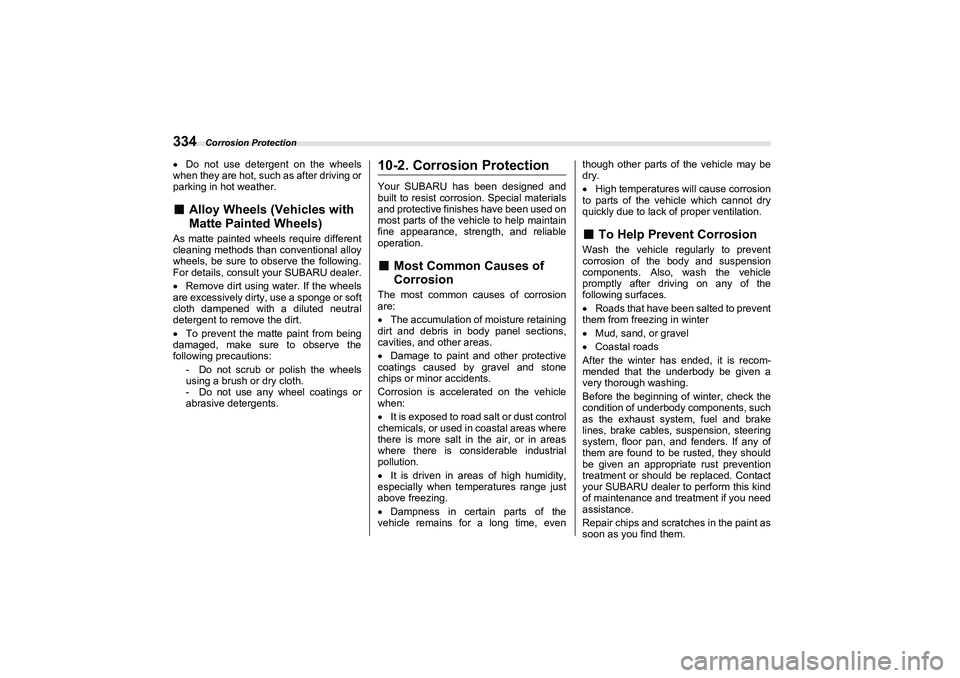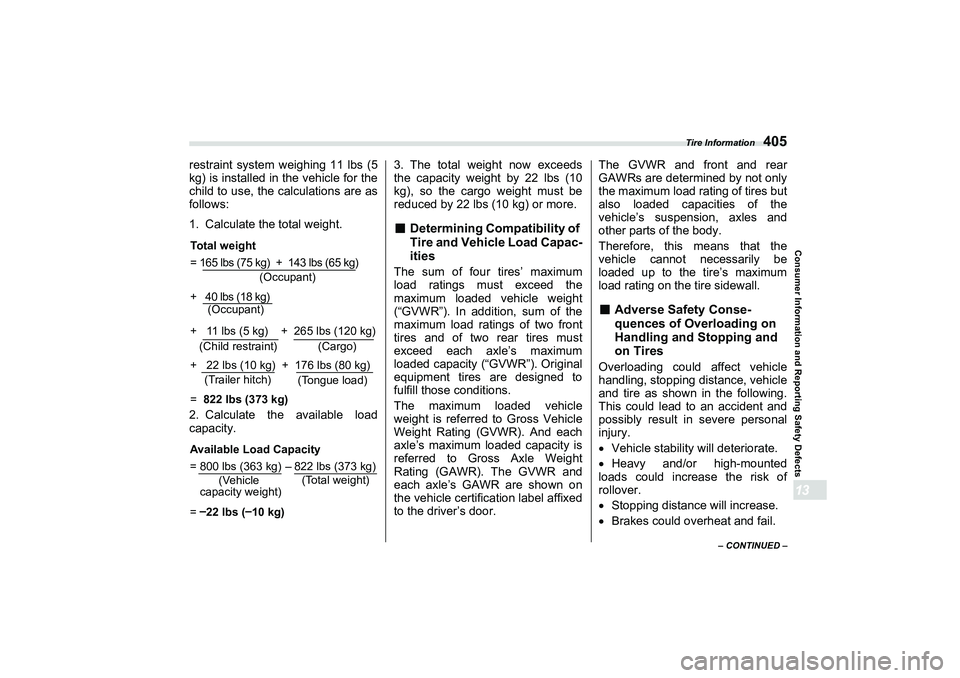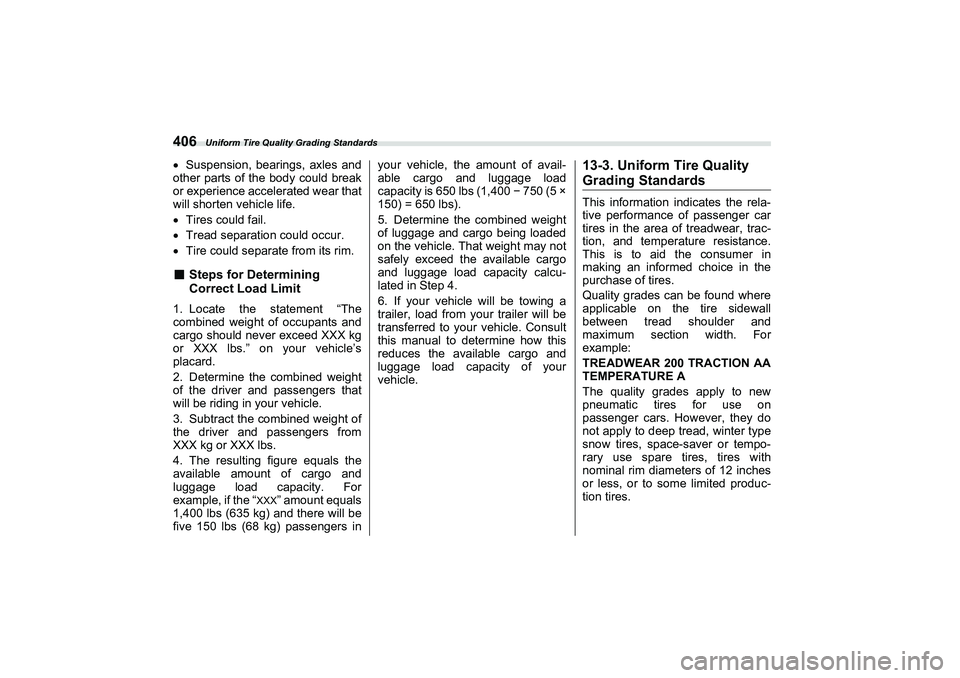2022 SUBARU BRZ suspension
[x] Cancel search: suspensionPage 339 of 432

Exterior Care
333
Appearance Care10
– CONTINUED –
▼
Using a warm water washer
Keep a good distance of 12 in (30 cm)
or more between the washer nozzle and
the vehicle.
Do not wash the same area continu-
ously.
If a stain will not come out easily, wash
by hand. Some warm water washers are
of the high temperature, high pressure
type, and they can damage or deform the
resin parts such as mouldings, or cause
water to leak in to the vehicle.
■
Waxing and Polishing
Always wash and dry the vehicle before
waxing and polishing.
Use a good quality polish and wax and
apply them according to the manufac-
turer’s instructions. Wax or polish when
the painted surface is cool. Be sure to polish and wax the chrome trim,
as well as the painted surfaces. Loss of
wax on a painted surface leads to loss of
the original luster and also quickens the
deterioration of the surface. It is recom-
mended that a coat of wax be applied at
least once a month, or whenever the
surface no longer repels water.
If the appearance of the paint has dimin-
ished to the point where the luster or tone
cannot be restored, lightly polish the
surface with a fine-grained compound.
Never polish just the affected area, but
include the surrounding area as well.
Always polish in only one direction. A No.
2000 grain compound is recommended.
Never use a coarse-grained compound.
Coarser grained compounds have a
smaller grain-size number and could
damage the paint. After polishing with a
compound, coat with wax to restore the
original luster. Frequent polishing with a
compound or an incorrect polishing tech-
nique will result in removing the paint layer
and exposing the undercoat. When in
doubt, it is always best to contact your
SUBARU dealer or an auto paint
specialist.
NOTEBe careful not to block the windshield
washer nozzles with wax when waxing
the vehicle.■
Cleaning Alloy Wheels
Promptly wipe the alloy wheels clean of
any kind of grime or agent. If dirt is left on
too long, it may be difficult to clean off.
Do not use soap containing grit to clean
the wheels. Be sure to use a neutral
cleaning agent, and later rinse thoroughly
with water. Do not clean the wheels with a
stiff brush or expose them to a high-speed
washing device.
Clean the vehicle (including the alloy
wheels) with water as soon as possible
when it has been splashed with sea water,
exposed to sea breezes, or driven on
roads treated with salt or other agents.
CAUTION
Be careful not to damage brake
hoses, sensor harnesses, and
other parts when washing
suspension components.Be careful not to flush the engine
bottom for a long time. It may
cause damage of some electrical
parts.
CAUTION
Do not use any agents with organic
solvents on the surface of the bulb
assembly cover. However, if a pol-
ish or wax with organic solvents is
applied to the cover surface, com-
pletely wipe off the polish or wax.
Otherwise, the cover surface may
be damaged.
B�5�=�B�8.�E�R�R�N 333 ページ 2021年7月5日 月曜日 午後>1時>1>1分
Page 340 of 432

Corrosion Protection
334Do not use detergent on the wheels
when they are hot, such as after driving or
parking in hot weather.■
Alloy Wheels (Vehicles with
Matte P ainted Wheels)
As matte painted wheels require different
cleaning methods than conventional alloy
wheels, be sure to observe the following.
For details, consult your SUBARU dealer.
Remove dirt using water. If the wheels
are excessively dirty, use a sponge or soft
cloth dampened with a diluted neutral
detergent to remove the dirt.
To prevent the matte paint from being
damaged, make sure to observe the
following precautions:
- Do not scrub or polish the wheels
using a brush or dry cloth.
- Do not use any wheel coatings or
abrasive detergents.
10-2. Corrosion ProtectionYour SUBARU has been designed and
built to resist corrosi on. Special materials
and protective finishes have been used on
most parts of the vehicle to help maintain
fine appearance, strength, and reliable
operation.■
Most Common Causes of
Corrosion
The most common causes of corrosion
are:
The accumulation of moisture retaining
dirt and debris in body panel sections,
cavities, and other areas.
Damage to paint and other protective
coatings caused by gravel and stone
chips or minor accidents.
Corrosion is accelera ted on the vehicle
when:
It is exposed to road salt or dust control
chemicals, or used in coastal areas where
there is more salt in the air, or in areas
where there is considerable industrial
pollution.
It is driven in areas of high humidity,
especially when temperatures range just
above freezing.
Dampness in certain parts of the
vehicle remains for a long time, even though other parts of the vehicle may be
dry.
High temperatures will cause corrosion
to parts of the vehicle which cannot dry
quickly due to lack of proper ventilation.
■
To Help Prevent Corrosion
Wash the vehicle regularly to prevent
corrosion of the body and suspension
components. Also, wash the vehicle
promptly after driving on any of the
following surfaces.
Roads that have been salted to prevent
them from freezing in winter
Mud, sand, or gravel
Coastal roads
After the winter has ended, it is recom-
mended that the underbody be given a
very thorough washing.
Before the beginning of winter, check the
condition of underbody components, such
as the exhaust system, fuel and brake
lines, brake cables, suspension, steering
system, floor pan, and fenders. If any of
them are found to be rusted, they should
be given an appropriate rust prevention
treatment or should be replaced. Contact
your SUBARU dealer to perform this kind
of maintenance and treatment if you need
assistance.
Repair chips and scratches in the paint as
soon as you find them.
B�5�=�B�8.�E�R�R�N 334 ページ 2021年7月5日 月曜日 午後>1時>1>1分
Page 369 of 432

Tires and Wheels
363
Maintenance and Service11
– CONTINUED –
■
Wheel Balance
Each wheel was correctly balanced
when your vehicle was new, but the
wheels will become unbalanced as
the tires become worn during use.
Wheel imbalance causes the
steering wheel to vibrate slightly at
certain vehicle speeds and detracts
from the vehicle’s straight-line
stability. It can also cause steering
and suspension system problems
and abnormal tire wear. If you
suspect that the wheels are not
correctly balanced, have them
checked and adjusted by your
SUBARU dealer. Also have them
adjusted after tire repairs and after
tire rotation.
NOTEThe suspension system is
designed to hold each wheel at a
certain alignment (relative to the
other wheels and to the road) for
optimum straight-line stability
and cornering performance.■
Wear Indicators1) New tread
2) Worn tread3)
Tread wear indicator
Each tire incorporates a tread wear
indicator, which becomes visible
when the depth of the tread grooves
decreases to 0.063 in (1.6 mm). A tire must be replaced when the
tread wear indicator appears as a
solid band across the tread.
NOTEFor safety, inspect the tire tread
regularly and replace the tires
before their tread wear indicators
become visible.
CAUTION
Loss of correct wheel align-
ment causes the tires to wear
on one side and reduces the
vehicle’s running stability.
Contact your SUBARU dealer
if you notice abnormal tire
wear.
12
3
B00327
WARNING
When a tire’s tread wear indi-
cator becomes visible, the tire
is worn beyond the accept-
able limit and must be
replaced immediately. With a
tire in this condition, driving at
high speeds in wet weather
can cause the vehicle to
hydroplane. The resulting loss
of vehicle control can lead to
an accident.
B�5�=�B�8.�E�R�R�N 363 ページ 2021年7月5日 月曜日 午後>1時>1>1分
Page 411 of 432

Tire Information
405
Consumer Information and Reporting Safety Defects13
– CONTINUED –
restraint system weighing 11 lbs (5
kg) is installed in the vehicle for the
child to use, the calculations are as
follows:
1. Calculate the total weight.
2. Calculate the available load
capacity.3. The total weight now exceeds
the capacity weight by 22 lbs (10
kg), so the cargo weight must be
reduced by 22 lbs (10 kg) or more.
■
Determining Compatibility of
Tire and Vehicle Load Capac-
itiesThe sum of four tires’ maximum
load ratings must exceed the
maximum loaded vehicle weight
(“GVWR”). In addition, sum of the
maximum load ratings of two front
tires and of two rear tires must
exceed each axle’s maximum
loaded capacity (“GVWR”). Original
equipment tires are designed to
fulfill those conditions.
The maximum loaded vehicle
weight is referred to Gross Vehicle
Weight Rating (GVWR). And each
axle’s maximum loaded capacity is
referred to Gross Axle Weight
Rating (GAWR). The GVWR and
each axle’s GAWR are shown on
the vehicle certification label affixed
to the driver’s door. The GVWR and front and rear
GAWRs are determined by not only
the maximum load rating of tires but
also loaded capacities of the
vehicle’s suspension, axles and
other parts of the body.
Therefore, this means that the
vehicle cannot necessarily be
loaded up to the tire’s maximum
load rating on the tire sidewall.
■
Adverse Safety Conse-
quences of Overloading on
Handling and Stopping and
on TiresOverloading could affect vehicle
handling, stopping distance, vehicle
and tire as shown in the following.
This could lead to an accident and
possibly result in severe personal
injury.
Vehicle stability will deteriorate.
Heavy and/or high-mounted
loads could increase the risk of
rollover.
Stopping distance will increase.
Brakes could overheat and fail.
Total weight
= 165 lbs (75 kg) + 143 lbs (65 kg)
+ 40 lbs (18 kg)
+ 11 lbs (5 kg) + 265 lbs (120 kg)
+ 22 lbs (10 kg) + 176 lbs (80 kg)
= 822 lbs (373 kg) (Occupant)
(Cargo)
(Trailer hitch)
(Child restraint)
(Tongue load)
(Occupant)Available Load Capacity
= 800 lbs (363 kg) 822 lbs (373 kg)
=
22 lbs ( 10 kg)(Vehicle
capacity weight) (Total weight)
A4600BEscusenvhch13.fm 405 ページ 2021年7月9日 金曜日 午後4時39分
Page 412 of 432

Uniform Tire Quality Grading Standards
406Suspension, bearings, axles and
other parts of the body could break
or experience accelerated wear that
will shorten vehicle life.
Tires could fail.
Tread separation could occur.
Tire could separate from its rim.■ Steps for Determining
Correct Load Limit1. Locate the statement “The
combined weight of occupants and
cargo should never exceed XXX kg
or XXX lbs.” on your vehicle’s
placard.
2. Determine the combined weight
of the driver and passengers that
will be riding in your vehicle.
3. Subtract the combined weight of
the driver and passengers from
XXX kg or XXX lbs.
4. The resulting figure equals the
available amount of cargo and
luggage load capacity. For
example, if the “
XXX
” amount equals
1,400 lbs (635 kg) and there will be
five 150 lbs (68 kg) passengers in your vehicle, the amount of avail-
able cargo and luggage load
capacity is 650 lbs (1,400
− 750 (5 ×
150) = 650 lbs).
5. Determine the combined weight
of luggage and cargo being loaded
on the vehicle. That weight may not
safely exceed the available cargo
and luggage load capacity calcu-
lated in Step 4.
6. If your vehicle will be towing a
trailer, load from your trailer will be
transferred to your vehicle. Consult
this manual to determine how this
reduces the available cargo and
luggage load capacity of your
vehicle.
13-3. Uniform Tire Quality Grading StandardsThis information i ndicates the rela-
tive performance of passenger car
tires in the area of treadwear, trac-
tion, and temperature resistance.
This is to aid the consumer in
making an informed choice in the
purchase of tires.
Quality grades can be found where
applicable on the tire sidewall
between tread shoulder and
maximum section width. For
example:
TREADWEAR 200 TRACTION AA
TEMPERATURE A
The quality grades apply to new
pneumatic tires for use on
passenger cars. However, they do
not apply to deep tread, winter type
snow tires, space-saver or tempo-
rary use spare tires, tires with
nominal rim diameters of 12 inches
or less, or to some limited produc-
tion tires.
A4600BEscusenvhch13.fm 406 ページ 2021年7月9日 金曜日 午後4時39分